.png)
In recent years, the shampoo category in Vietnam - especially on E-commerce platforms-has witnessed intense competition, coming not only from long-established local brands but also from ambitious international brands, driven by increasingly diverse consumer needs. According to Buzzmetrics’ observations, some brands have recognized and leveraged social media to shape consumers’ purchase intentions.
In this context, the following article by Buzzmetrics helps marketers explore:
According to IndexBox, Vietnam’s shampoo market is forecast to continue strong growth over the next five years, increasing from 239 million USD in 2024 to 332.65 million USD in 2029, equivalent to a growth rate of 39.2%. This is a highly competitive playing field, with the participation of both international corporations (Sunsilk, L’Oréal Paris, Dove, Pantene) and long-established local brands (Nguyên Xuân, Thái Dương, Cocoon).
The category’s potential is also clearly reflected on E-Commerce platforms. The market is dynamic, with a wide range of consumer needs and product lines spanning from mass to premium. While each need represents a distinct share, the largest revenue contributions come from Anti Hair Fall (accounting for 17.1% of AOV contribution) and Hair Damage Repair (accounting for 28.0% of AOV contribution). Within these two needs, premium and above product lines are relatively favored, contributing nearly half of total revenue.
Focusing on the Hair Damage Repair need, although no single brand fully dominates the market, clear positioning differences emerge. Domestic brand N primarily concentrates on the mass segment, while international brands focus on the premium segment. Most notably, Brand X-an international brand expanding into the shampoo category-has demonstrated strong growth in the premium segment. What is the secret behind Brand X's growth?

Brand X is an international name with an established position in the Skincare industry. In the period from the first half of 2024 to the first half of 2025, the Skincare segment slowed in growth rate, showing signs of market saturation. This prompted the brand to expand into the Haircare field – a transformative strategic decision.
This decision became a major turning point, reflected in significant E-Commerce revenue growth. While Skincare revenue saw a slight increase, Haircare revenue exploded with 182% growth, rising from 37 billion to 105 billion VND within one year.
.png)
Buzzmetrics’ analysis shows that although Brand X ranked second in E-Commerce revenue, its Social Media Buzz Volume was lower than that of several competitors. Does this mean Brand X succeeded without relying on Social Media?
In reality, despite having lower Buzz Volume, Brand X recorded a relatively high correlation score between Social Media discussions and E-Commerce revenue compared to other brands. This metric reflects the brand’s ability to optimize Social Media communications to deliver tangible business outcomes on E-Commerce platforms. In other words, Brand X focused on generating fewer but higher-quality discussions - conversations capable of shaping purchase intent and driving conversion. So what stood out in Brand X’s Social Media journey to enable this success?
.png)
First, Brand X focused its communication on two flagship product lines: the Gold Product and the Pink Product. These products directly addressed Anti Hair Fall and Hair Damage Repair-the two largest consumer needs on E-Commerce. Notably, the brand prioritized combo sets rather than single products, aligning with the growing consumer trend toward comprehensive haircare routines.
Second, instead of fragmented communications scattered across retail channels, Brand X built an integrated multi-channel strategy with Owned Media and KOLs at its core. Examining the relationship between Social Media discussions and E-Commerce revenue growth reveals two distinct phases:
.png)
Thus, selecting products aligned with user needs and building a structured communication strategy helped the brand achieve significant growth in E-Commerce. On Shopee, revenue for the two product lines, X Gold Product and X Pink Product, increased by +82% after the campaign. On TikTok Shop, the growth rate reached +210%.
Brand X implemented a harmonious multi-channel strategy by synchronizing communication across Owned Media, Influencers, Online Sellers, and Retailers, focusing on the two flagship product lines, X Gold Product and X Pink Product. Analyzing the distribution of social media discussions by channel, Owned Media and Influencers/KOLs proved most effective in generating significant engagement with just a few posts.
.png)
However, the growth of one brand can also lead to the stagnation of another. This is partly evident when directly comparing with Brand N – a relatively strong player. Before October 2024, Brand N performed better on E-Commerce. However, by late 2024, when Brand X accelerated with its Social → E-Commerce campaign, Brand N began to stall. Meanwhile, Brand X surged ahead to lead with 189% growth.
This is clear evidence that: With the right insight, the right message, and the right channel, Social Media not only builds brand awareness but becomes a genuine driver of revenue growth. The effectiveness of an integrated Social-E-commerce strategy lies not only in boosting the brand itself but can also reshape the market the brand participates in.
➤ The shampoo category remains one of the most dynamic industries and is projected to continue strong growth in the coming years. Beyond its large market size, the category offers significant potential thanks to diverse consumer needs, varied product segments, and consumers’ willingness to pay.
➤ International brands entering the Vietnam shampoo market should prioritize the premium segment, particularly products addressing Anti Hair Fall and Hair Damage Repair needs.
➤ From Brand X’s case study, one key insight stands out: E-Commerce growth is not directly proportional to Social Media “buzz volume,” but rather to the quality of discussions. Brands must therefore identify the right consumer insights, clearly define the role of each communication channel, and coordinate Social Media and E-Commerce seamlessly to guide consumers from consideration to purchase.

_11zon.webp)
As winter arrives, demand for warm-fashion on social media surges and gives rise to distinct seasonal consumer behaviors. Buzzmetrics research shows that knitwear is not only an essential wardrobe item but has also evolved into an emotionally meaningful product—often chosen to express care for loved ones during the year-end period. This article analyzes social media discussion data and offers content directions to help brands optimize their communications for the peak season.
As early as September, social media users were beginning to stir conversations about warm clothing. However, the real surge only erupted during the November–December period, when mentions of warm apparel peaked at 1.86 million in December (+48.5%).
Notably, knitwear emerged as an unmissable item. Starting in October, discussion of knitwear recorded a record growth of +108.3%, signaling a clear shift in user preferences as people proactively searched for fashion pieces at the onset of colder weather. The appeal of knitwear stayed strong, peaking at nearly 740,000 mentions in December.
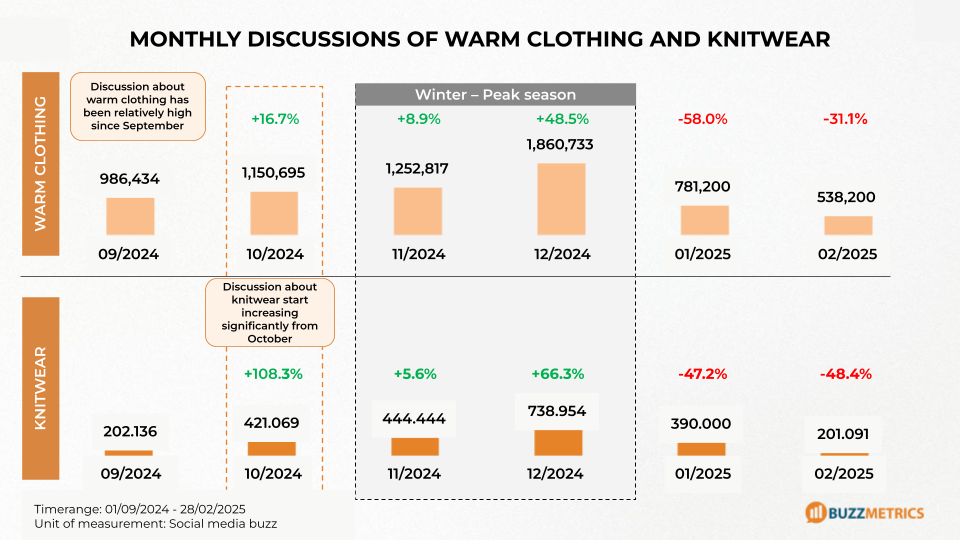
When we dig deeper into discussions about knitwear, the root causes of this “craze” show a clear split: conversations in the North account for the majority of total volume and peaked in December 2024, driven mainly by preparations for the autumn–winter season, Christmas, and shared travel experiences to extremely cold destinations like Harbin (Cáp Nhĩ Tân). By contrast, the peak in the South is smaller and is primarily driven by non-weather factors such as brand promotion campaigns and online retailers’ clearance sales. This suggests that while growth in the North is fueled by practical demand, brands can still spark strong conversations in the South through commercial events and discount campaigns.

Data shows that conversations related to gift-giving account for 34.7% of all discussions—making it a new growth driver for the knitwear category. Consumers view knitwear as a way to express care and affection, especially toward parents, partners, and loved ones. This presents an opportunity for brands to expand their positioning, shifting from a focus on “warming functionality” to highlighting its “emotional value” during the festive season.

Despite strong purchasing motivation, choosing knitwear still faces major barriers—chief among them unstable weather and the product’s limited adaptability. Among all concerns, “getting too hot indoors or during activities” accounts for 38.3% of discussions, while “difficulty in washing/cleaning” makes up 34.4%. With unpredictable temperature shifts, consumers constantly struggle with the question: “What can I wear that keeps me warm in the early morning but doesn’t overheat me by noon?”. These challenges, combined with worries about stretching and pilling, have created a clear market need: brands must guide consumers toward knitwear options that can flexibly adapt to a variety of weather conditions.

To address the barrier of “difficulty adapting to changing weather,” brands should prioritize solution-oriented content. Instead of showcasing single products, build outfit combinations tailored to specific scenarios: cold mornings–warm afternoons, work–leisure, or extreme-cold travel. The rise of TikTok creates a strong opportunity for Mix & Match videos with KOLs/Reviewers, demonstrating real-life situations and reducing consumer hesitation. For example, major brands like Uniqlo frequently collaborate with TikTok creators such as @emi and @Pecao Review to produce Mix-and-Match style guides.
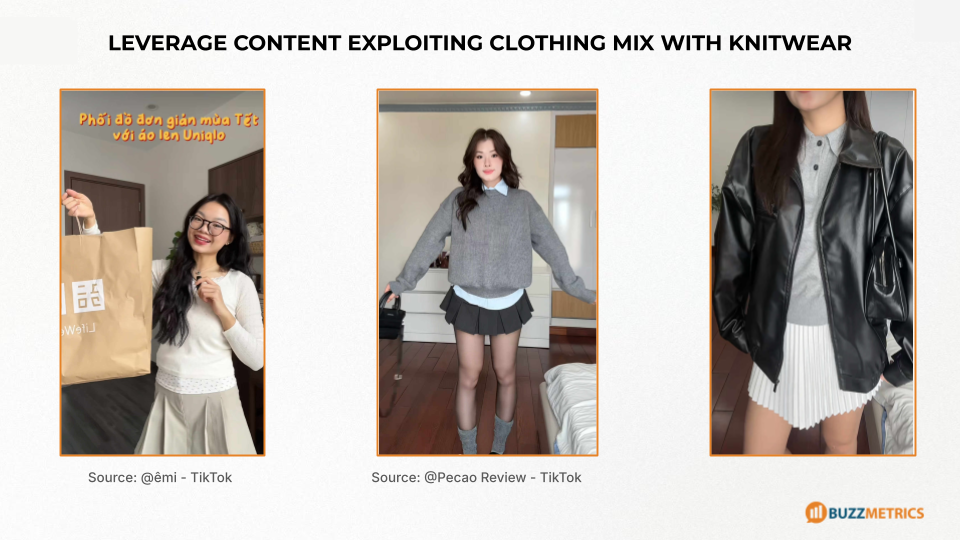
Data show that gift-giving is not just a passing trend but a key growth driver for the knitwear market, accounting for 34.7% of discussions about purchase motivations. Consumers view knitwear as a way to express care—especially for family members—so brands should shift their messaging from “just keeping warm” to positioning knitwear as a “gift of care”: highlight emotion, gifting stories, and thoughtful gestures instead of focusing solely on functionality.

As another winter approaches, knitwear continues to be a must-have category for every fashion brand. Beyond its warming function, social media data shows a strong emotional driver: knitwear is increasingly seen as an expression of care and affection — a sentiment that now dominates much of the conversation and creates clear commercial opportunities. To capitalize on this shift, brands should:


Buzzmetrics analysis shows that when choosing treatment products, consumers no longer prioritize price or instant effectiveness. Instead, they value safety and natural origin - a new definition of “effective treatment.” This article decodes this trend and the opportunities it brings for brands.
From discussion trends and consumer insights in the Pharmaceutical industry, the preference for safe and natural products has been validated and widely spread, influencing both purchasing behavior and the healthcare market. Let’s join Buzzmetrics in decoding this trend through the lens of social media conversation analysis, to uncover meaningful consumer insights.
In the process of analyzing consumer behavior in the healthcare category, Buzzmetrics identified a clear shift, particularly reflected in discussions related to the pharmaceutical category. Specifically, when it comes to treatment methods involving medication, social media users make a clear distinction between Eastern and Western Medicine. Based on over a year of discussion data from March 2024 to February 2025, their usage behavior and areas of interest have shown significant differentiation and change.
In early 2024, discussions around both Eastern and Western Medicine hovered at approximately 200,000 mentions per month. After one year, the total discussion volume surged, reaching 1,063,037 mentions by February 2025 - reflecting significantly higher interest from social media users compared to the same period last year. A closer look at the trendlines reveals notable fluctuations in the gap between discussions on Eastern and Western Medicine.
Overall, the trend shows that discussions on Eastern Medicine accounted for a significantly larger share, consistently surpassing those on Western Medicine. At certain points, the gap reached nearly double.
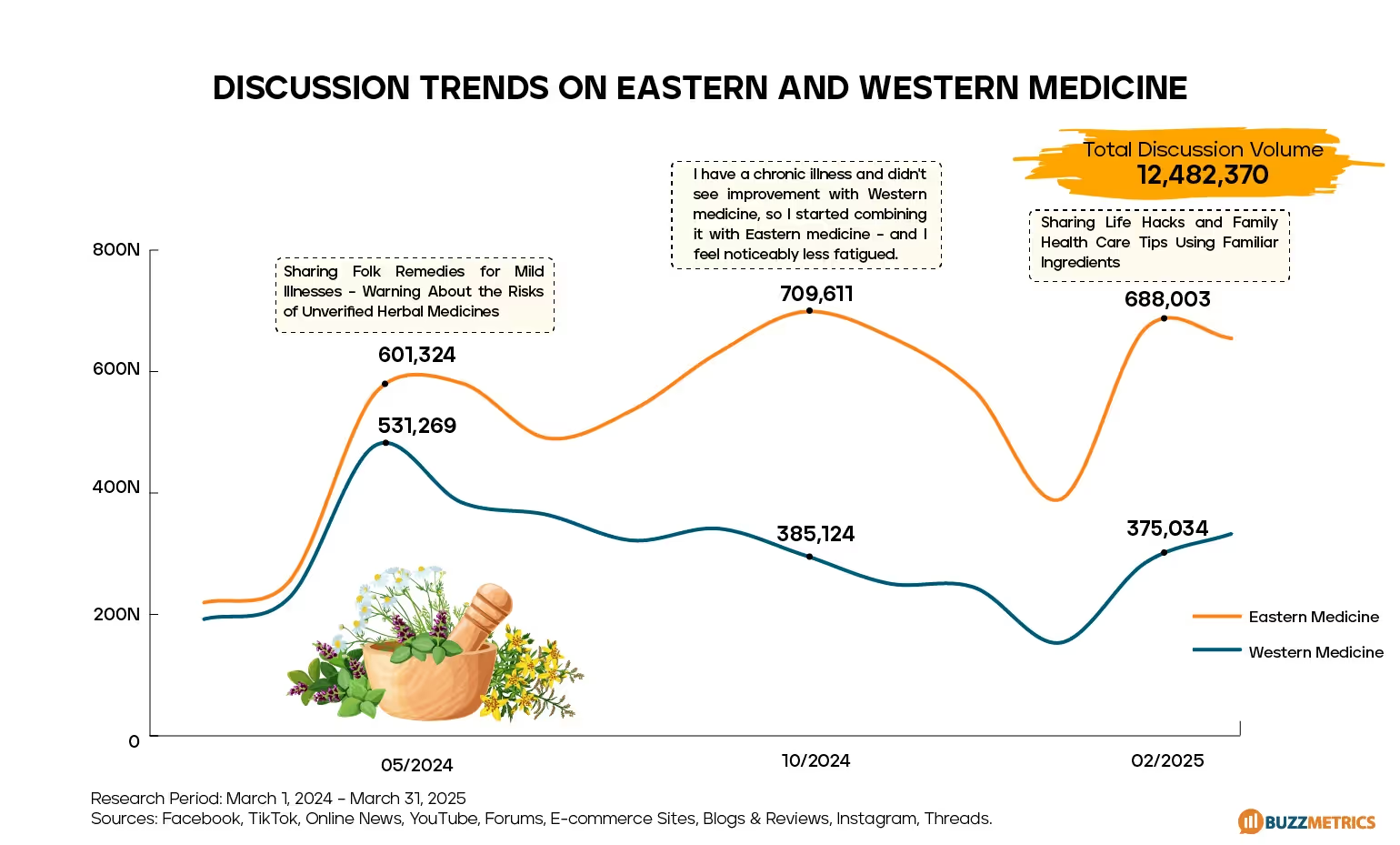
Given the significant differences in discussion volume, why is Eastern Medicine being mentioned more frequently by users than Western Medicine?
In terms of severity, illnesses are divided into two groups: serious and non-serious. For serious illnesses, treatment decisions largely depend on medical indications and doctors' expertise. Therefore, this report focuses on non-serious illnesses - where users tend to take a more proactive role, with over 1.8 million people participating in related discussions.
.avif)
Within this group, illnesses are further divided based on user behavior and treatment preferences. For acute symptoms that require immediate attention such as fever (105,064 mentions) or headache/ dizziness (133,572 mentions), users tend to favor Western Medicine for its fast-acting effects and ability to quickly manage the situation. In contrast, for more prolonged symptoms like insomnia, fatigue or sore throat, Eastern Medicine is preferred due to the perception of being “safe - non-exhausting - long-term use without side effects”.
In addition, several common symptoms such as stomachache, flu and nasal congestion are discussed in relation to both treatment approaches - highlighting the intersection between Eastern and Western Medicine.
Users choose Eastern Medicine not only for its effectiveness, but also for its perceived qualities: safety, natural ingredients, and minimal long-term health impact. This reveals a key insight: Eastern Medicine is seen as a sustainable approach to healthcare, rather than a quick-fix treatment.
Notably, acute conditions remain the “domain” of Western Medicine. However, based on emerging trends and the expectation factors previously analyzed, Eastern Medicine brands can tap into the potential of treating acute conditions with recurring and lingering symptoms, leveraging their perceived advantages of being safe, gentle and targeting the root cause of the illness.

Beyond treatment effectiveness, users primarily choose Eastern Medicine based on two key factors: safety - gentleness and natural origin. Specifically:
For the same group of conditions, users express concerns about two key issues when using Western Medicine:
These factors drive more careful consideration, particularly for recurring or long-lasting issues.
Although Eastern Medicine is viewed positively, users still hold clear expectations for its products: maintain gentleness, enhance convenience and elevate trust standards.
Ultimately, users are not only seeking gentle solutions, but also expecting modern Eastern Medicine to elevate the overall experience: combining traditional values with the convenience -reliability of modern healthcare.
From an emotional sentiment perspective, the core difference between Eastern and Western Medicine is not only in treatment capability, but also in the user’s emotional experience.
Clearly, users do not deny the role of Western Medicine in urgent situations. However, they are increasingly unwilling to “trade off” long-term health for immediate effectiveness. The feeling of safety has become an equally important factor and even more positively perceived (38.8% of discussions) than treatment effectiveness itself (20.1% of discussions).
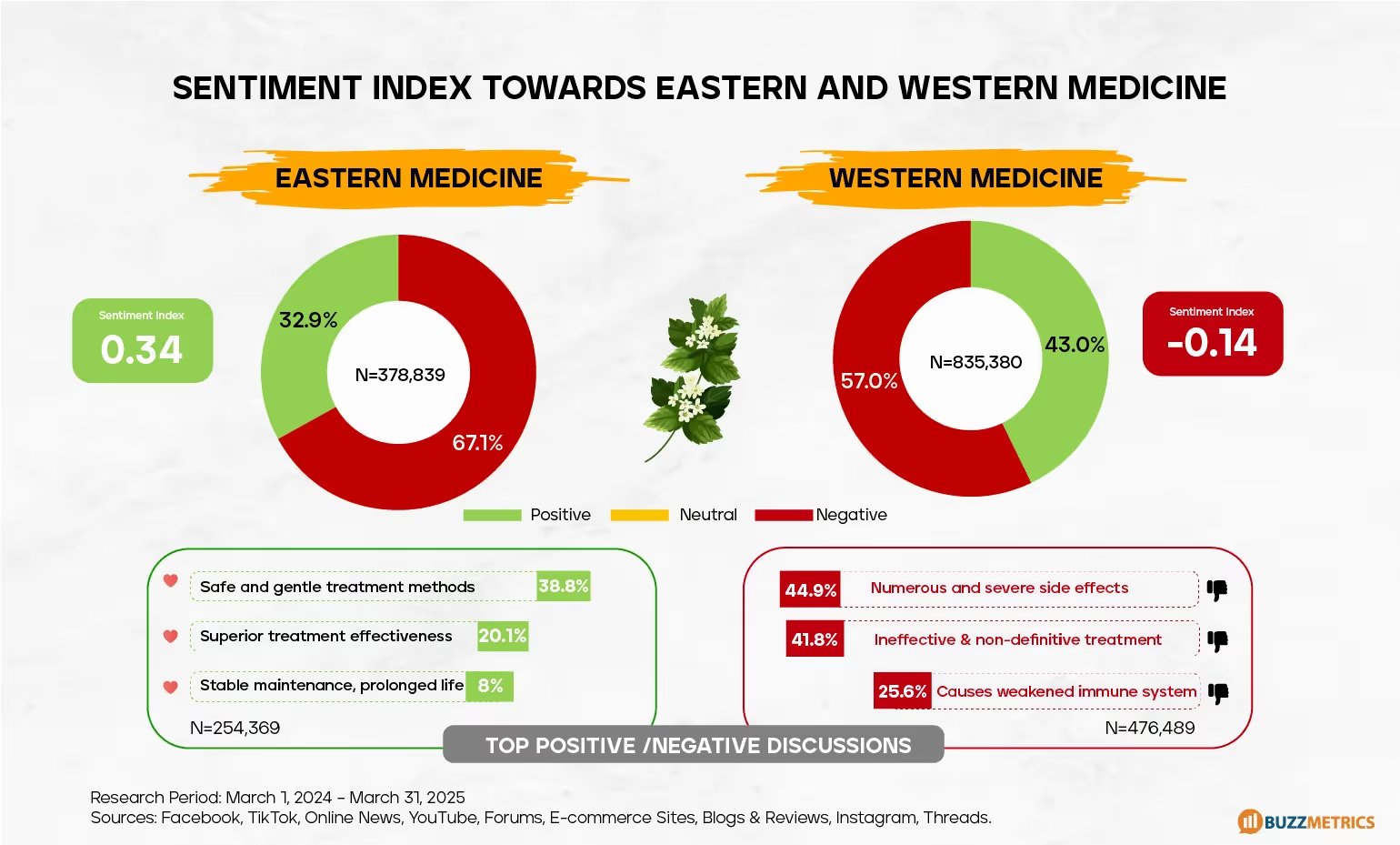
The consumer trend of prioritizing safe, gentle and naturally sourced products is no longer limited to the Pharmaceutical industry, it is now expanding across various industries related to healthcare and everyday well-being.
According to Euromonitor (2023), the natural haircare market in Vietnam has reached a value of nearly USD 1 billion - clearly reflecting the growing demand for beauty solutions that emphasize long-term care and safety.
The factor of being “safe for the whole family” - from children to the elderly - is becoming a baseline standard when consumers choose personal care products.
One notable example is Nguyen Xuan - a herbal-based shampoo brand - which has made a breakthrough thanks to its clear positioning strategy and alignment with user insights.
Nguyen Xuan has succeeded by telling a consistent brand story that directly addresses the key consumer expectations analyzed in Section 2:
These messages are consistently echoed and affirmed by users in real conversations, creating a strong trust loop.

Buzzmetrics data confirms that this strategy has delivered tangible business results:
Nguyen Xuan’s success is a clear testament to the power of capturing the right user insight and transforming it into a consistent communication and product strategy.
By combining emotional cues such as “safety” and “gentleness” with strong, action-oriented messaging, the brand not only earned consumer trust but also converted it into tangible business results.
The shift in consumer behavior - from prioritizing quick effectiveness to valuing safety, gentleness and natural origin - is reshaping not only the Pharmaceutical industry but also influencing other industries like healthcare and beauty. Positive emotional experiences and the sense of “peace of mind when using” are emerging as new competitive drivers, offering long-term advantages to brands that truly understand and meet evolving consumer expectations.


Influencer Marketing is a powerful tool for healthcare brands in Vietnam to enhance brand awareness and build trust. However, to optimize effectiveness, brands need to choose the right group of influencers, personalize content, and implement campaigns that align with each stage of the customer journey. At the same time, due to the sensitivity of the industry, preparing a crisis management plan is an essential factor in protecting reputation against potential risks.
This article is the next part in the series analyzing the healthcare industry. In Part 1, Buzzmetrics analyzed the market context, consumer behavior, and the impact of Influencer Marketing on the healthcare sector. Building on that, Part 2 will focus on how to create an effective plan, from selecting the right group of influencers to optimizing content and managing risks, helping brands fully leverage the potential of this channel.
The Influencer Marketing industry in the healthcare sector in Vietnam is growing rapidly. After a boom period, the number of Influencers focusing on healthy lifestyles has exceeded 1,700, spanning across Mega, Macro, Micro, and Nano levels. Data from Buzzmetrics shows that the two main platforms, Facebook (59%) and TikTok (41%), lead in terms of presence, with Micro-Influencers making up the majority. This creates opportunities for brands to launch diverse campaigns, from brand awareness to driving purchasing behavior.
Influencer Marketing is no longer just a trend but has become a strategic channel that helps healthcare brands deeply connect with Vietnamese consumers. However, to fully tap into its potential, brands need to build a well-structured plan: selecting the right group of Influencers, optimizing content, and implementing it at the right time.
_5.png)
Based on Buzzmetrics' analysis, each group of Influencers plays a distinct role in the consumer's product journey:
_6.png)
Depending on the group of Influencers and the stage of the campaign, brands should consider using the appropriate type of content and presentation format. Below are suggestions for optimizing content for the Healthy Lifestyle Influencer group.

In addition to traditional Influencer groups such as celebrities or doctors, the media and online communities are also highly engaged with social issues related to health. The Fear Marketing strategy (exploiting fear to drive action) often works well with these channels but can also easily become a 'spark' for a media crisis if the content is not tightly controlled.
Real-life Example: Pfizer once collaborated with doctors to explain vaccines via videos on YouTube and TikTok, achieving millions of views in the 2021-2022 campaign. In Vietnam, KOCs are creating significant buzz with reviews of immune-boosting supplements, turning unfamiliar products into familiar choices in just a few weeks.
Takeaway: The success of Influencer Marketing lies in selecting the right people, telling engaging stories, and creating an emotional connection with consumers. When the right group of Influencers is combined with creative content, brands can not only increase recognition but also build long-term trust.
The healthcare industry is sensitive, where Influencer Marketing brings great benefits but also carries risks if not properly managed. Some common mistakes to avoid include:
To mitigate risks, brands need to prepare a solid Crisis Management script: from action plans when negative reactions occur to close cooperation with Influencers on non-Owned Channels. This not only protects the brand’s image but also maintains consumer trust.
Case Study: The Media Crisis of Vegetable Supplement Pills with Hằng Du Mục - Quang Linh Vlog & Thùy Tiên – A Social Media Research Perspective

First, based on the discussion data, the incident unfolded according to the ‘Social Media Crisis’ model (Social Crisis) with two peaks, as shared by Buzzmetrics.
The issue originated from a community channel when a TikToker had a dietary supplement (TPCN) tested, and the actual results did not match the advertised content. Within just three days, the discussion reached its first peak when the authorities got involved. Communication responses such as the Influencer’s apology, cooperation with authorities, and especially the “friendly” press conference, created the second peak of the discussion just seven days later. According to Buzzmetrics’ crisis communication model, after five days from the first peak, the brand failed to manage the situation promptly and lacked official sources of information, causing the discussion to linger at a level of 4-5K buzz – a sign that a second peak would emerge.
As of now, after the official announcement of the violations and the handling measures from the authorities, the issue has cooled down. However, considering the quality of the response and the feedback from the online community, the brand’s crisis management has not been entirely effective
_9.avif)
Additionally, in terms of the quality of the discussions, measured by the Sentiment Score (emotional tone) – an important indicator to capture user sentiment trends when managing a crisis – this incident recorded an overall low score of -0.62. From February 24 to March 25, there were up to 60K negative discussions about the brand and product. Notably, at the first peak of the discussion (March 7), the positive/negative discussion ratio was 28%, but by the press conference a week later (March 14), this dropped to 22% and continued to decline until March 21.
Clearly, the brand was unprepared and missed the "golden time" to manage the crisis in a structured manner, leading to the increase of negative sentiment over time. The lack of transparency, openness, and clarity on Owned Channels also significantly contributed to the ineffective crisis management.
Key Takeaway:
The Sentiment Score is a crucial metric for evaluating the effectiveness of crisis management, helping brands adjust their strategies in a timely manner.


Influencer Marketing has become an indispensable "weapon" in the marketing strategy of the healthcare product industry in Vietnam. With impressive growth rates, increasing consumer demand, and the explosion of discussions on social media, this industry is opening up golden opportunities for brands looking to reach users effectively.
By leveraging HCPs (Healthcare Professionals) to build credibility, KOLs to spread messages, and KOCs to drive purchase behavior, Influencer Marketing not only shapes awareness but also has a powerful impact on consumer behavior. However, to fully harness this potential, brands need to choose the right influencer groups, optimize content, and remain vigilant against potential risks such as non-transparent advertising or media crises.
Below, Buzzmetrics will provide a deeper analysis of the industry context, consumer behavior, and how to effectively utilize Influencer Marketing in the healthcare sector.
The healthcare product industry in Vietnam, including pharmaceuticals, dietary supplements (DS), and medical devices, is experiencing strong growth. The dietary supplement market reached a size of approximately 2.4 billion USD in 2022, with a compound annual growth rate (CAGR) of 7% (2023-2028), according to Euromonitor. In addition, the trend towards natural products and personal medical devices such as blood pressure monitors and smart thermometers is becoming a highlight that attracts consumers.
On social media, the appeal of this industry is even more evident. With 56 million discussions in one year (2023-2024) and 11 million active participants, this reflects a high level of community interest.
A notable statistic from NielsenIQ (2023) reveals that Vietnamese consumers, particularly younger groups, are increasingly relying on social media to search for health product information. Among them, 70% of 'Cautious Spenders' and 'Rebounders' depend on trusted sources like social media to make purchasing decisions.

Especially after the COVID-19 pandemic, discussions around health have surged, with TikTok emerging as a leading platform thanks to its short video format. Moreover, the increasing presence of KOLs and KOCs in the healthcare industry has sparked a new wave, attracting attention and engagement from users.
In this context, Influencer Marketing has become a prominent marketing channel due to its ability to enhance both quantity and quality, as well as diversify targeting. From doctors sharing health tips on TikTok (HCPs) to major brands like Pfizer and Sanofi collaborating with medical experts, influencers are impacting various stages of the product experience journey— from awareness to purchase decisions.
Key Takeaway: Influencer Marketing is a powerful tool for changing consumer awareness and behavior, especially when leveraging formats like short videos and personalized content.

The healthcare industry in Vietnam is witnessing a significant shift in how consumers access information. No longer solely relying on traditional channels like hospitals or the press, users now turn to social media as their primary source for discovering, discussing, and deciding on health-related matters. However, the industry faces a large amount of information being "distorted" by the Online Seller group, which can cause users to become lost in a maze of information.

Amid the overwhelming amount of discussions and information, users still choose to refer to and trust discussions from two main groups:

Key Takeaway: HCPs, KOLs, and KOCs are not just communication channels but also trusted companions for consumers in healthcare. Brands need to understand the strengths of each group to optimize campaigns at each specific stage.


Launched in the Vietnamese market in January 2024, the Mitsubishi Xforce is considered the 'dark horse' of the Vietnamese automotive scene. In fact, just this past July 2024, the Xforce reached the top spot for the first time on the list of best-selling cars in Vietnam, with 1,748 units sold. Additionally, the Xforce generated significant discussion among users on Vietnamese social media, with 15,515 buzz mentions. What has made the Xforce attract such attention? Let’s explore through the lens of Buzzmetrics' Social Listening in the article below.
Despite only being launched earlier this year, the Mitsubishi X-Force garnered 15,515 mentions, placing it in the top 10 most-discussed car models on social media between January 1, 2024, and July 31, 2024. Notably, when compared to other B-SUV segment models, the X-Force ranks just behind the Toyota Vios and Kia Sonet, with its discussion volume almost matching that of the well-established Kia Sonet (15,579 mentions).
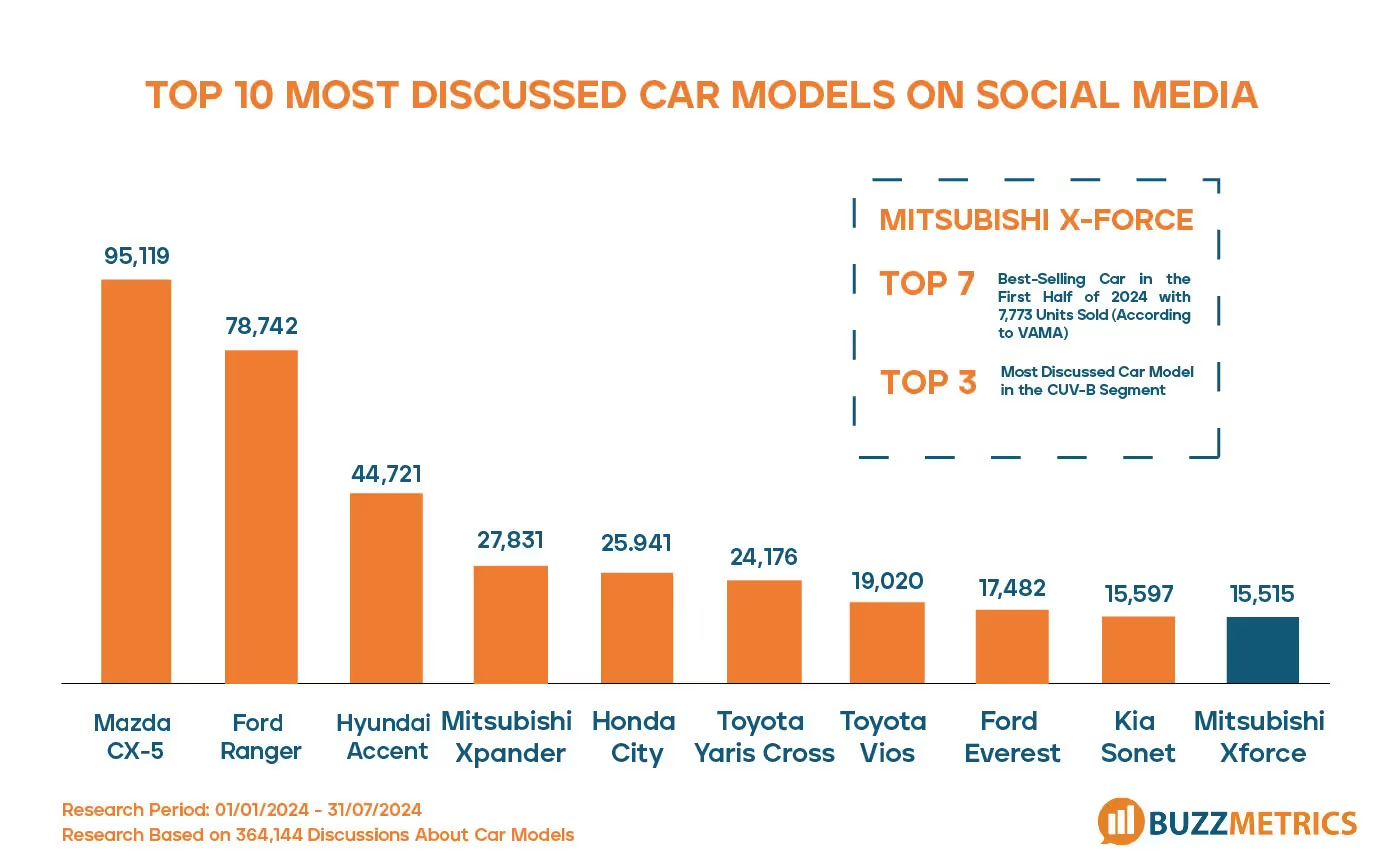
Observing the discussion trends, the volume of discussions about the Mitsubishi X-Force surged in March 2024 when Mitsubishi Motors Vietnam, along with its official authorized dealers, delivered the All-New X-Force to customers. This event attracted significant attention from the community, causing the discussion volume to peak at a total of 2,753 discussions.
Later, in June, the volume of discussions gradually increased as dealers began accepting deposits for the Ultimate version – the highest trim of the new Mitsubishi X-Force. The anticipation of the vehicle arriving in Vietnam and being delivered in July further heightened customer excitement and interest, resulting in a gradual increase in discussions, reaching 2,371 discussions in July.
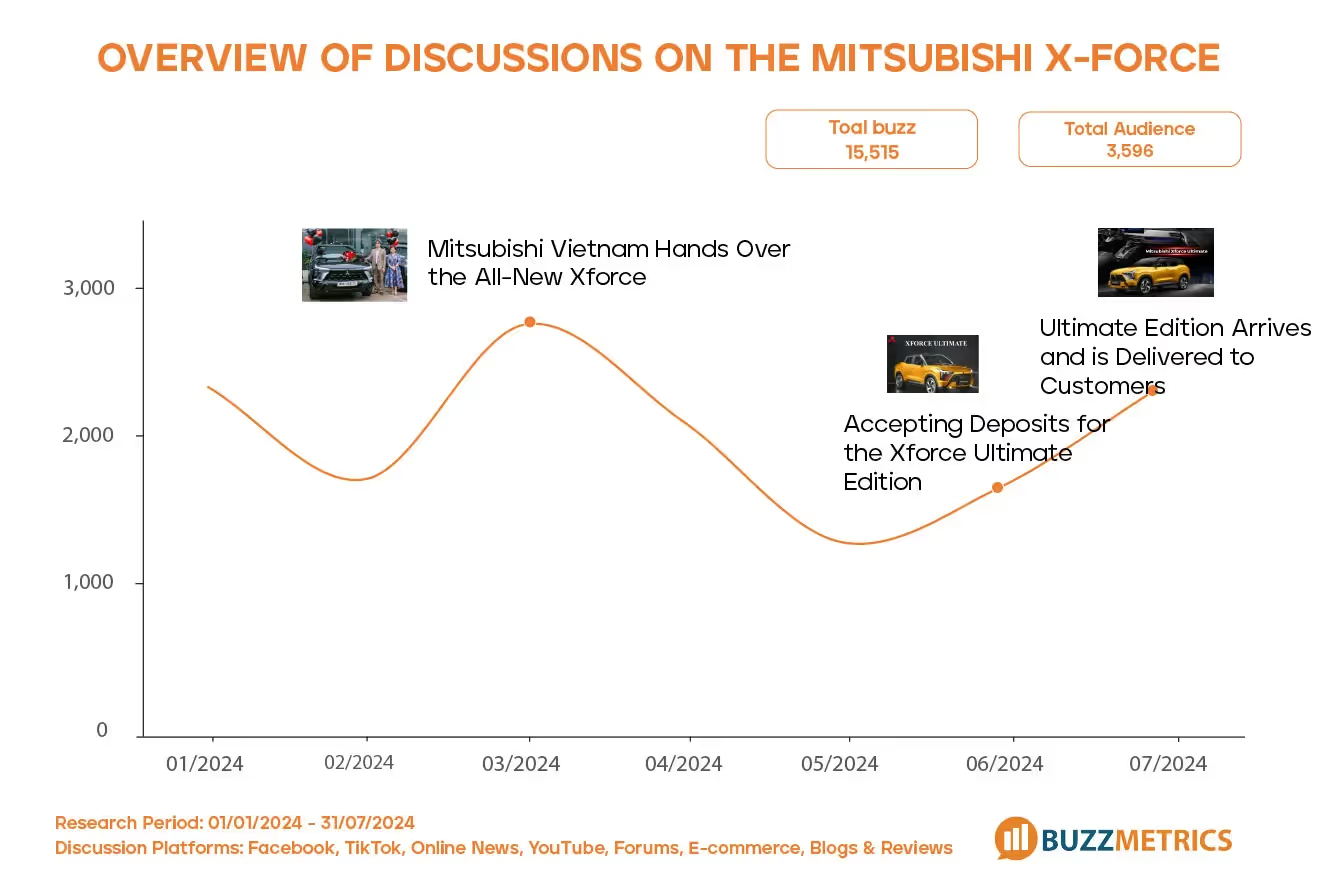
In the first seven months of 2024, from January 1 to July 31, Facebook was the most frequently used platform for discussing the Mitsubishi X-Force on social media. On fanpages, particularly in community groups dedicated to XFC vehicle users, individuals regularly share personal impressions and reviews of the design and features of the Mitsubishi X-Force. This has created a vibrant discussion community where potential consumers can seek opinions from those who have had real-world experience.
TikTok is also a valuable platform for discussing the automotive industry, capturing 31.29% of the discussion share, second only to Facebook. TikTok should be prioritized in communication activities due to its ability to showcase the outstanding design features of both the interior and exterior through short-form video content. Mitsubishi has skillfully utilized TikTok to highlight features and test drive experiences, and has collaborated with influencers to enhance discussions around the X-Force model.

This vehicle line is quite lively with diverse discussions from the brand, users, sellers, and online media on social networks, including:
(1) The largest volume of discussions comes from sellers, clearly reflecting the strong spread of the Mitsubishi X-Force across distribution channels. The role of sellers goes beyond providing product information; they are a crucial bridge between the brand and customers. Through these discussions, sellers contribute to shaping customer perceptions and building trust in the new vehicle line.
(2) User-generated discussions account for a significant proportion, indicating that users are not just passively receiving information but actively sharing their opinions and personal experiences. Capturing and analyzing these discussions will help Mitsubishi better understand customer needs and expectations, allowing for more effective adjustments to marketing strategies.
(3) Following this are discussions from brand voice and online media channels. Online media is an essential source if the brand wants to reinforce its image and provide reliable information to consumers.
Delving deeper into consumer discussions on social media, the top concerns of users when choosing a car brand are:

The X-Force was also developed by Mitsubishi to meet the needs of Southeast Asian consumers. In fact, the development team from the Japanese automaker even came to Vietnam to study market preferences and demands before launching a suitable commercial version. Therefore, it is no surprise that the two key factors—'Design' and 'Price'—are also pivotal in the appeal of this vehicle in the market.
In analyzing consumer voice related to the Mitsubishi X-Force, the two most prominent factors that consumers discuss and pay attention to are price (29.6%) and design (24.9%):
The ratio of positive to negative discussions is also quite stable, centering around praise for the vehicle's design and its affordable price.
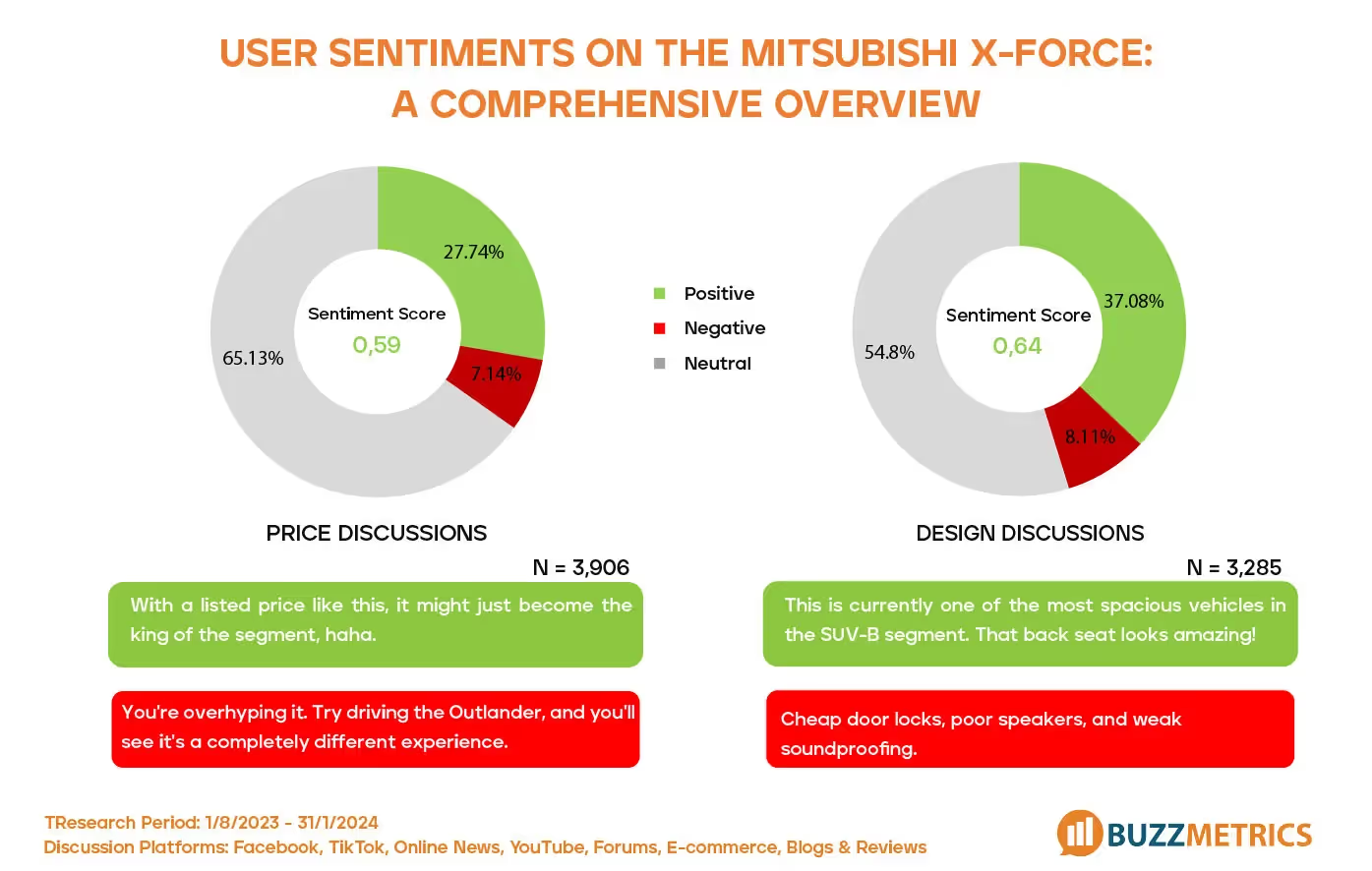
It can be said that addressing users' concerns has helped the 'newcomer' X-Force quickly climb to the top 10 best-selling vehicles in the first half of the year despite its recent launch.
It can be observed that design and price are the two strategic (must-win) factors that primarily influence consumer perceptions and behaviors in the automotive industry. These are the factors that the brand must focus on first and secure at all costs. By understanding user insights, Mitsubishi has chosen to highlight 'price' and 'design' (functional benefits) rather than wasting money on campaigns building abstract images of the good life (emotional benefits). This approach helps customers accurately understand the product.
Specifically, Mitsubishi X-Force effectively emphasizes 'design' and 'price' in its communication activities:

Communication campaigns that focus on evoking emotions (emotional benefits), such as Toyota's ‘Start Your Impossible’ campaign, can create strong emotional connections with customers. However, they are not always effective in driving purchase behavior, especially when fundamental factors like design and price are not addressed first. Instead of dispersing resources across multiple campaigns that may not yield optimal results, Mitsubishi chose to concentrate resources on communication activities that highlight aspects they know Vietnamese consumers care about the most, such as continuous minigame activities to generate naturally spreading UGC content, along with a nationwide series of display events. This is a smart approach to ensure maximum effectiveness for every dollar spent.
Although Mitsubishi did not conduct as many large-scale promotional campaigns as competitors, it made effective use of its dealer network and sales team. This is a wise approach, leveraging available resources to boost sales. Dealers and salespeople can provide direct consultation, address inquiries, and support buyers, significantly influencing purchasing decisions.


The vaccine industry plays a crucial role in public health, helping to prevent and control the spread of infectious diseases, protect community health, and reduce the risk of outbreaks. However, as a sensitive sector with significant impact on public health, vaccine brands must adhere to strict regulations in their communication efforts. In this context, understanding users' concerns and anxieties is essential for accurate and effective communication on social media.
Vaccines are a critical aspect of public health, essential for preventing and controlling the spread of infectious diseases. However, given its significant impact on public health, the vaccine industry must adhere to strict communication regulations. Understanding user concerns and anxieties is key for accurate and effective social media communication.

Flu vaccines are among the most discussed types due to their importance in preventing widespread and potentially serious illnesses, particularly for vulnerable groups such as the elderly, children, pregnant women, and those with underlying conditions.
Previously, social media discussions primarily focused on the effectiveness of flu vaccines in preventing seasonal flu, with stable engagement. Recently, some have speculated that flu vaccines might help prevent COVID-19, though this is not yet proven, highlighting the need for clear and accurate information about flu vaccines' effectiveness and role in public health.

On social media, discussions about flu vaccines vary significantly across different groups. Mothers with young children are the most prominent, making up about 60-80% of the conversations. This indicates their strong focus on protecting their children's health through vaccination. Meanwhile, older adults, caregivers, and those with underlying health conditions represent around 20-40% of the discussions, mainly concentrating on safeguarding their own and their loved ones' health against flu, particularly given the heightened risks associated with age and health conditions.
Flu vaccine discussions often blend positive and negative sentiments, addressing several key topics. A major point of interest is vaccine availability, with users frequently debating whether flu vaccines are easily accessible and if the supply is stable enough to meet demand. Concerns about vaccine side effects are also significant, with many people worried about potential adverse reactions and overall safety. Lastly, the importance of vaccination is highlighted, with discussions focusing on the benefits of flu vaccines in preventing illness and protecting public health.
In the past four years, flu vaccines have played a crucial role in encouraging early vaccination due to their high effectiveness in boosting immunity. With COVID-19 emerging as a pandemic in 2021 and initial distrust in COVID-19 vaccines, flu vaccines became a viable option to protect against flu and respiratory infections, especially for children. Understanding the symptoms and severe complications of the flu has driven demand for flu vaccines to protect personal and family health.

The necessity of vaccines is pivotal in shaping vaccination decisions. Research from 2021 indicates that communities with high flu vaccination rates experience significantly lower rates of flu illness and outbreaks compared to those with lower vaccination rates. This highlights the vaccine's effectiveness in preventing disease and controlling the spread of flu virus. When users understand the importance of vaccines in combating dangerous infectious diseases and maintaining community health, they are more likely to make responsible vaccination decisions.
Vaccines not only reduce the risk of illness but also provide protection for those unable to get vaccinated, such as young children or individuals with weak immune systems. Additionally, vaccination helps alleviate pressure on the healthcare system and reduces treatment costs. Awareness of these benefits can foster wider community consensus on vaccination.
A common barrier to flu vaccination has been the belief that vaccination is unnecessary. Many people think their immune system can protect them without vaccines, often due to a lack of information or misconceptions about the flu's dangers and the benefits of vaccination. Some suggest alternative methods like supplements or natural remedies to boost immunity and prevent the flu, believing these can replace vaccination. The popularity of these alternatives can diminish the priority given to flu vaccines in many people’s prevention plans.

Concerns about side effects and complications from flu vaccines also contribute to hesitation. Although serious incidents are rare, misinformation or negative personal experiences can cause fear and undermine confidence in vaccine safety. Addressing these challenges requires clear, transparent, and accessible information about vaccine benefits and safety to help the community understand and trust the vaccination process.
Vaxigrip and Influvac are two prominent flu vaccine brands discussed on social media, each with distinct communication strategies. Vaxigrip has established a strong market presence through effective campaigns, notably the Vaxigrip Tetra campaign in 2021, targeting vulnerable groups and leveraging social media to increase product awareness. This has helped Vaxigrip maintain a leading position in share of voice (SOV) over the years.
However, in 2023, Influvac surpassed Vaxigrip in SOV due to exclusive promotions and partnerships with major pharmacy chains and vaccination centers like Long Chau and VNVC. Influvac's strategies, including clear information about vaccine benefits and attractive promotions, helped it stand out and dominate the media landscape for the year.

The competition between Vaxigrip and Influvac on social media reflects not only the market share battle but also the importance of strategic communication in raising awareness and influencing consumer behavior regarding flu vaccination.
The vaccination industry is facing significant challenges on social media, particularly concerns about side effects and the perception that vaccination is unnecessary. To overcome these barriers, brands must enhance communication, tailor messaging for each age group, and collaborate with healthcare professionals to provide reliable information. Additionally, having a crisis management plan in place will help clarify the benefits of vaccines, transparently address concerns, and prevent misinformation, ultimately safeguarding public health and protecting brand reputation.


Media crises can happen to any brand at any time, especially in the age of booming social media. Therefore, building a specific response plan in case a media crisis occurs is a crucial factor in ensuring the brand's reputation in the market. In this article, Buzzmetrics will analyze a hypothetical crisis case study in the automotive industry. Through this, Buzzmetrics will offer suggestions for businesses to avoid mistakes when handling a crisis.
The case study data in this article is hypothetical, collected using Buzzmetrics' Social Listening tool, covering the crisis period from August 1, 2023, to January 31, 2024.
Summary of the Incident: In 2016, Toyota acquired all shares of Daihatsu. This partnership aimed to leverage Daihatsu’s expertise and technology, such as the DNGA platform, to develop compact vehicles. The communication crisis erupted in December 2023 when Toyota announced the suspension of Daihatsu vehicle sales due to safety fraud. Among the 20 affected models were Toyota Vios/Yaris vehicles using the DNGA platform. This also significantly impacted the Vietnamese market, as Toyota Vietnam announced on December 20, 2023, that it would temporarily halt the shipment of all Daihatsu-related vehicles to dealers for inspection.
With 33,962,264,150 discussions recorded from January 1, 2023, to December 31, 2023, the automotive industry is highly active on social media, with updates on the market, traffic, vehicle reviews, and buying/selling activities.

Despite being a dynamic industry with discussions from brands, online sellers, and consumers, the automotive sector is particularly sensitive to negative news, whether old or foreign. These negative stories often revolve around safety tests of airbags, vehicle undercarriages, etc.The question here is: How can brands protect their reputation and detect issues early? Or, in the worst-case scenario of a crisis, how can they mitigate risks and avoid a media crisis? Let’s explore how automotive brand A handled a crisis in the case study below.
In general, discussions about this brand surged in the second half of December when the crisis erupted in Vietnam on December 11, 2023. During other periods, conversations about the brand revolved only around the launch of new cars or vehicle reviews.
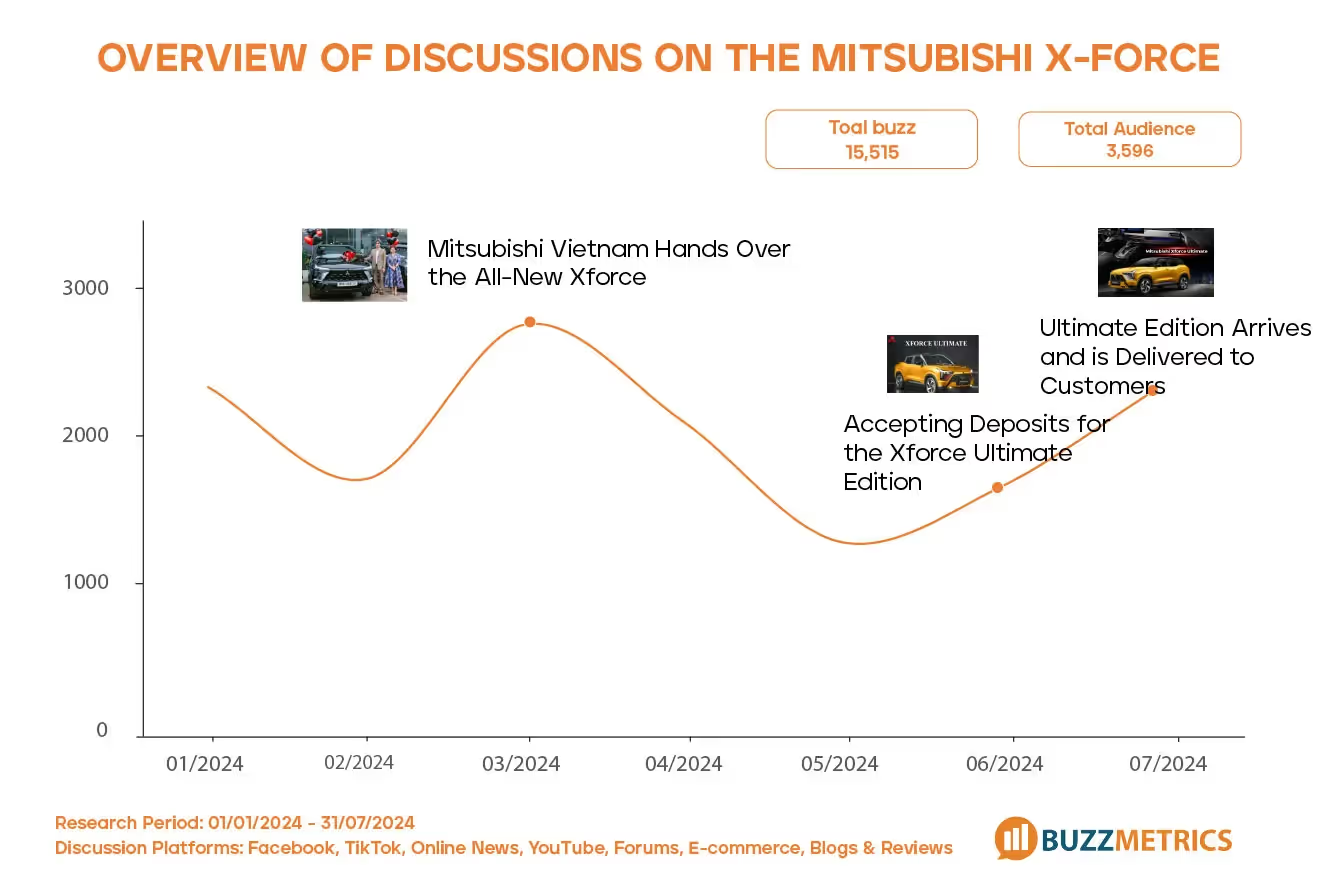
Looking closer, before the crisis occurred, brand discussions were relatively sparse and stable, remaining below 1,000 buzz, even during the product launch event in September 2023. This shows that while the launch of a new product is an important event, it was not enough to spark a significant surge in discussions on social media. During this period, the brand remained under control, facing no major public pressure or impact. However, from December 18, 2023, the crisis escalated, and discussions spiked dramatically to 8,489 buzz, an increase of about 8 times compared to normal levels. This sudden spike reflects not only a high level of public interest but also the potential danger and spread of the crisis. This crisis not only affected the brand's image but also posed the risk of widespread and prolonged consequences.
After the crisis broke out, the brand took timely action. This is evidenced by the rapid drop in buzz, forming a single peak on the chart. This is a positive sign, demonstrating that the brand had an effective crisis management plan, helping to stabilize the situation quickly and minimize damage.
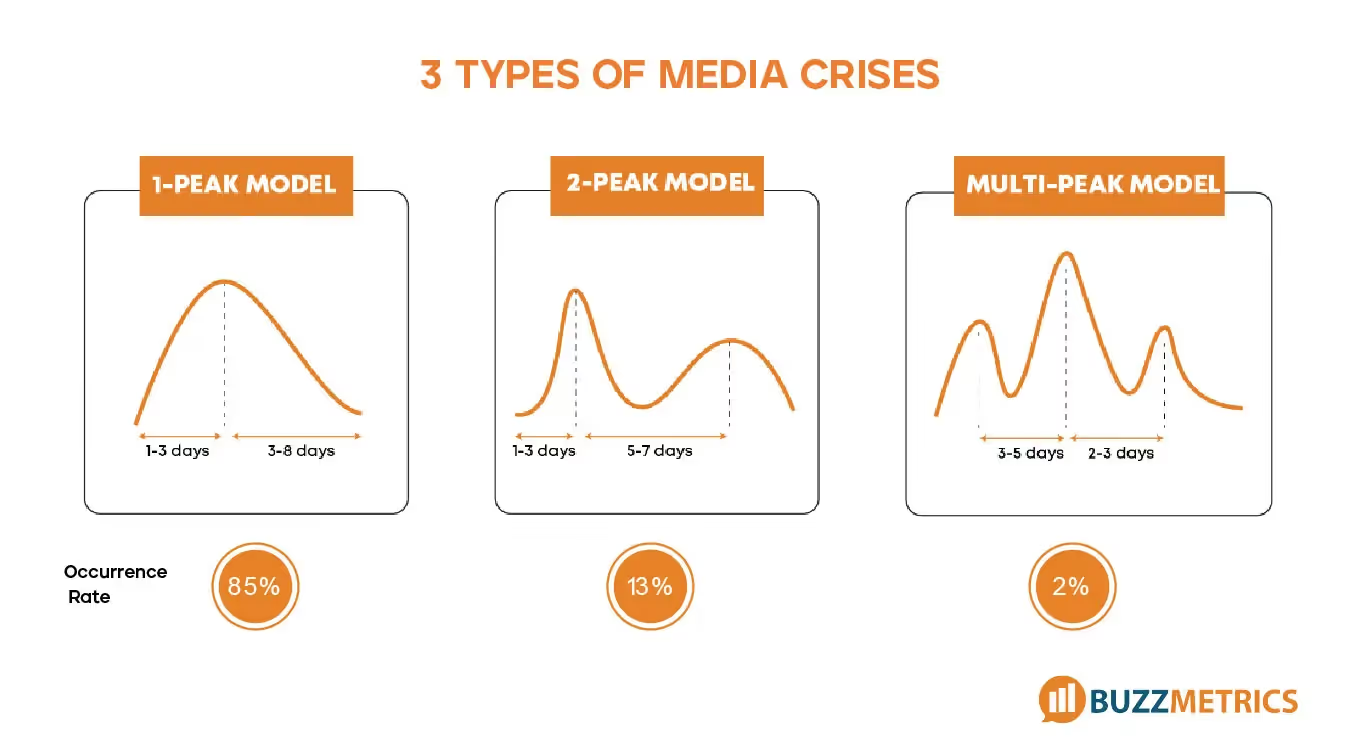
People often think that media crises occur randomly without any patterns. In reality, every media crisis follows one of three main models:
1-Peak Model
2-Peak Model
3-Multi-Peak Model
From August 1, 2024, to January 31, 2024, Facebook, online news sites, and forums were the three platforms most used when users discussed Toyota and the incident.
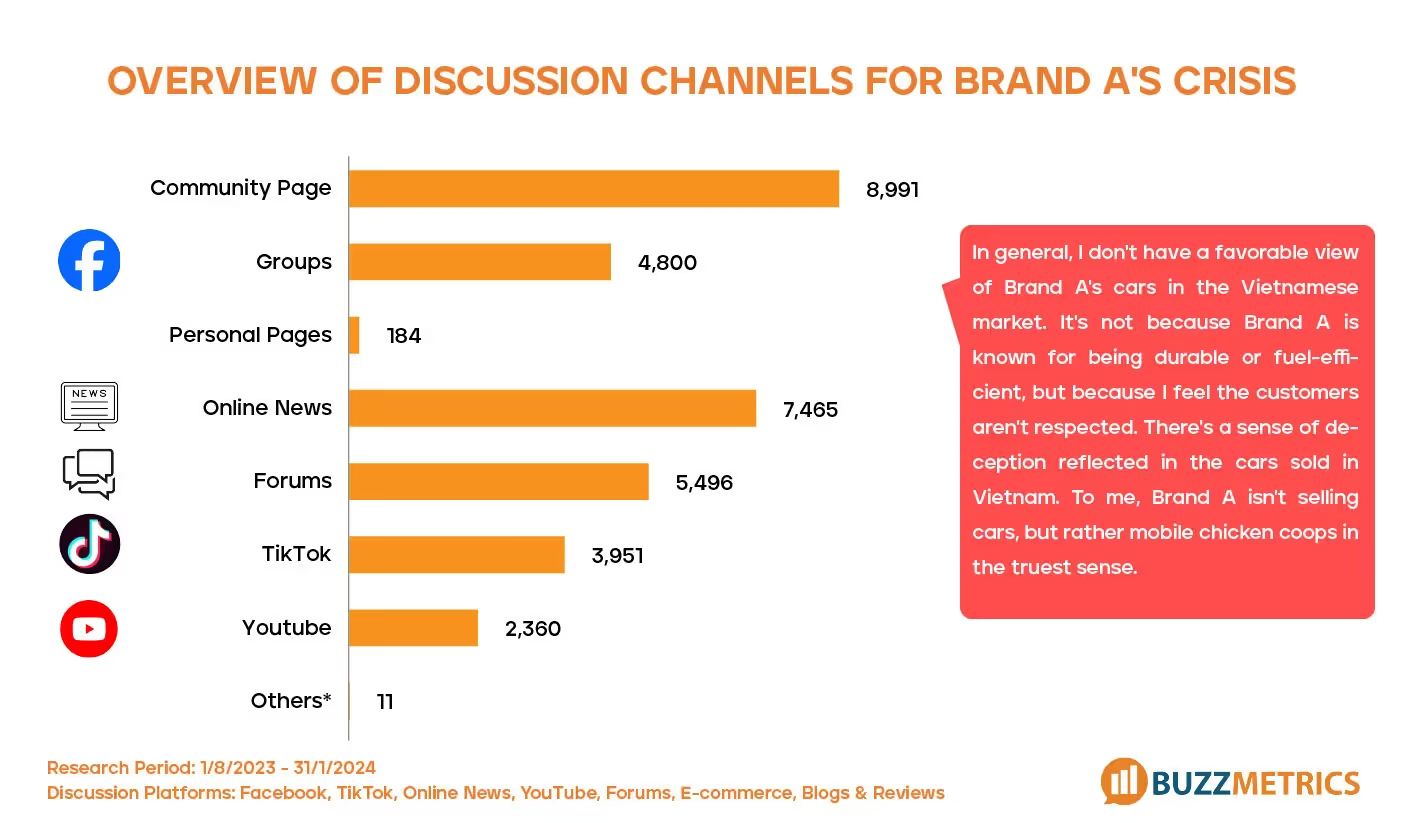
In December 2023, brand A’s crisis erupted on social media, with online news outlets serving as the source of the crisis. Specifically, several major news outlets in Vietnam reported that the brand had announced a halt on all newly manufactured vehicles due to violations related to safety testing. The situation truly escalated when a group of consumers began paying attention, discussing, and spreading the news on large forums such as Otofun and Beatvn, creating a massive wave in a short period.
The significant increase in negative discussions impacted users' trust in the quality of the car models.


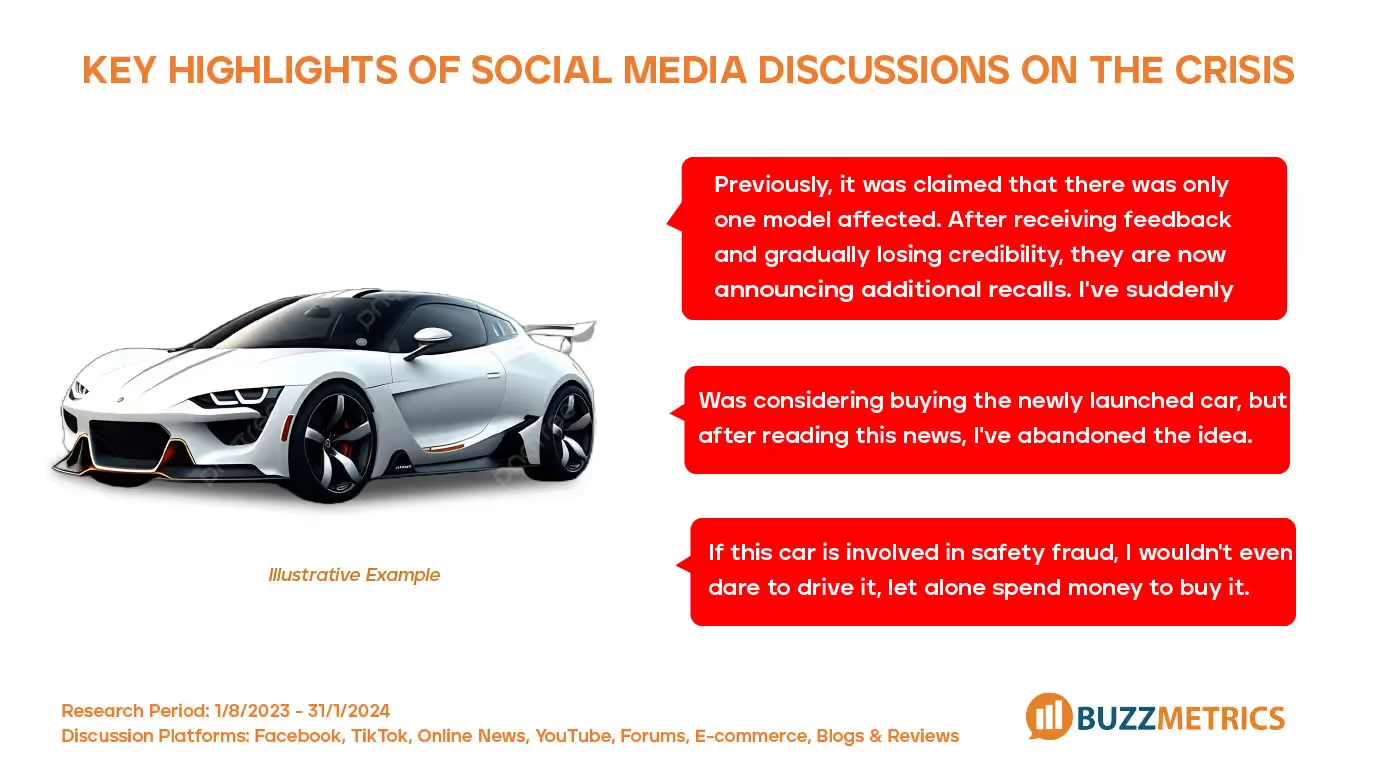
To resolve the crisis, it is essential to address the root cause – the true origin of the crisis. Since online news outlets were the primary medium for disseminating the crisis, Brand A immediately released PR articles to neutralize public sentiment.
Press outlets played a crucial role in conveying information to the community effectively, as official sources help build public trust and alleviate negative emotions. Besides major Vietnamese news platforms like Vnexpress.vn and Baomoi.com, specialized car market publications such as Otosaigon.com should also be prioritized for monitoring during incidents. The brand continuously updated accurate content about the situation, rectifying both accurate and inaccurate information to prevent the crisis from escalating beyond control. Transparency and a commitment to rectification will help rebuild customer trust in the brand.
According to Buzzmetrics' crisis management process, in the initial phase, besides running PR campaigns, the brand should also use seeding or launch an Advocacy Marketing campaign to guide public sentiment.

Alongside providing updates through paid media channels, the brand should use seeding to manage the narrative. Seeding positive content helps reshape public perception and counteract negative information. By strategically crafting a seeding scenario, the brand can steer conversations in a more favorable direction.
Some time after the crisis subsides, the situation will quiet down. This is the moment for the brand to intensify its communication regarding its car models, focusing on the functional benefits of the vehicles:


In just three days, VinFast VF3 has received a total of 27,649 early pre-orders, each valued at 15 million VND, resulting in a remarkable total of 414.735 billion VND. This success is attributed to the strategic use of targeted communication channels, while other automotive companies scatter their efforts across multiple platforms with generic key messages. This article will delve into VinFast VF3's communication strategy, providing valuable lessons for Vietnamese businesses in an increasingly saturated automotive market. If your automotive brand is searching for a reliable social media data research partner to develop effective communication strategies, explore Buzzmetrics' Automotive Solutions Package today: Buzzmetrics Automotive.
Measuring a brand's appeal goes beyond just sales figures and store coverage—it also involves capturing user attention on social media through engagement metrics. Upon its launch, the VinFast VF3 created a buzz online, registering a discussion volume of 218,500. This impressive figure placed it 4th in the Top 10 Most Discussed Topics on Social Media (from May 9, 2024, to May 15, 2024), trailing only major holidays and the summer season.
It’s rare for a vehicle to receive such a warm reception when the manufacturer hasn’t even started test drives and the car is still in the "pre-production" phase.

Read More: What Is the Buzzmetrics Social Index (BSI)?
Moreover, the VinFast VF3 deposit campaign has garnered significant attention, with 234,354 interactions. The balance between positive and negative discussions about the brand remains stable, focusing on topics such as special edition versions and sharing deposit confirmations.

To create a successful social media marketing campaign, identifying the right must-win channel is crucial. However, it’s not just about pinpointing the main channel; brands must delve deeper into what content their target audience is discussing. This allows for the customization of key messages to effectively win over consumers' minds. In this article, Buzzmetrics provides updated statistics on media channels and the top concerns of users when choosing to purchase electric vehicles for Q2 and early Q3 2024 (April 1, 2024 - July 24, 2024).
Source of Discussion
When executing a communications campaign, choosing the most crowded platform remains a steadfast rule. Facebook continues to be the top platform for marketers, accounting for 60.2% of discussions in the electric vehicle sector. Additionally, TikTok presents significant potential, capturing 28.9% of the discussion share and offering ample room for growth.

Top Concerns About Electric Vehicles Discussed on Social Media
A deeper look into social media discussions reveals the top concerns of users when choosing an electric vehicle brand:

Read More: Research Methods for Gaining Customer Insights Through Social Listening
Recognizing the importance of Facebook and TikTok as primary discussion platforms in the automotive industry, VinFast has strategically utilized these channels to enhance its online brand presence. Activities such as Mega Livestream and V-creator were implemented to increase brand recognition. To overcome price barriers and boost sales, VinFast introduced a series of discount codes and allowed deposits as low as 15 million VND during the livestream sessions.
The success of the VF3 launch campaign is attributed to the innovative use of livestreaming combined with Key Opinion Leaders (KOLs). While this approach is common for low-involvement products, it remains relatively new for high-involvement, high-value items like cars in Vietnam, previously seen mainly in China. VinFast pioneered this trend in the Vietnamese automotive market by collaborating with Key Opinion Consumers (KOCs) such as PewPew and ViruSs to promote and secure deposits for the VF3 on platforms like Shopee, Facebook, and TikTok. This unique approach generated significant social media buzz, with 108,100 interactions and 19,878 mentions.

Read more: Unveiling Influencer Marketing Trends
Understanding the power of social media and the content creator community, VinFast launched the V-creator program. Instead of relying on traditional advertising, VinFast leveraged the community's strength to produce authentic, relatable, and inspiring content such as reviews like "Test-driving the VF3 – A Car for a 5 Million VND Salary." This strategy not only expanded VinFast's brand reach but also fostered a positive image and attracted potential customers. Within just one week of launching, the program achieved impressive results with 197,476 interactions and 51,092 mentions.
VinFast personalized discount codes for its partners, such as exclusive discounts for Otofun members, to achieve strategic benefits:
When Otofun members used these discount codes and shared their experiences (User-Generated Content), it created a ripple effect, amplifying brand awareness within the automotive community. Within a week of its launch (May 9, 2024 - May 15, 2024), the VinFast VF3 achieved substantial media coverage with 10,491 interactions and 3,529 mentions.

